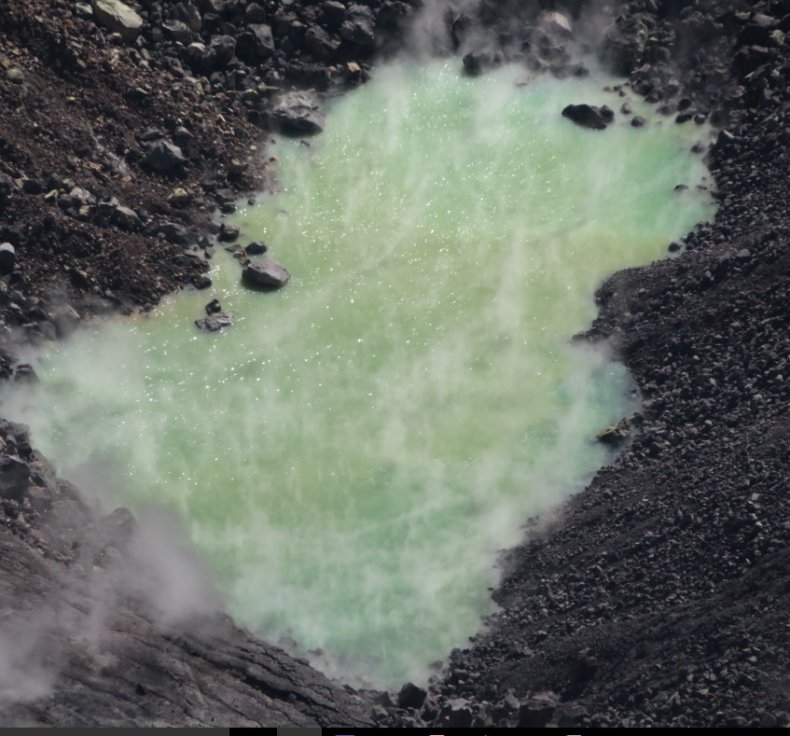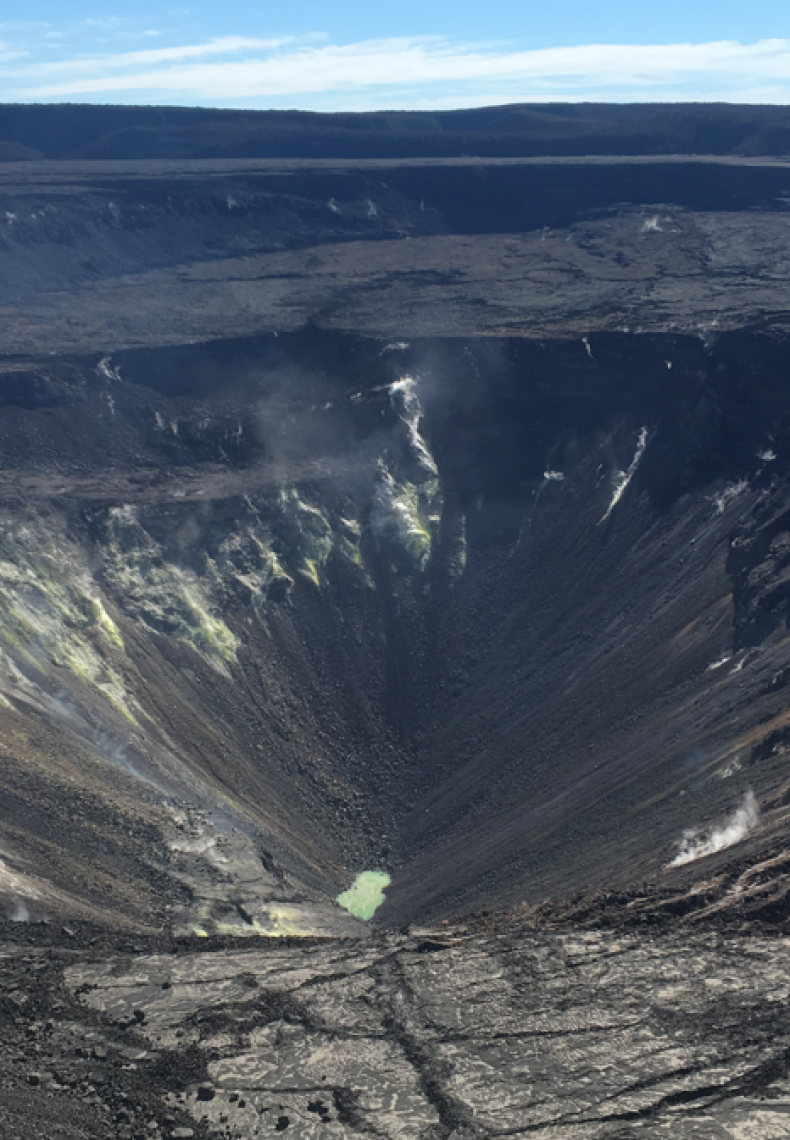BY HANNAH OSBORNE ON 9/2/19 AT 10:20 AM EDT
A pool of water that appeared inside a crater at Hawaii's Kīlauea volcano is growing and could end up being more than 200 feet deep. Scientists do not know where the boiling water filling the Halema'uma'u crater is coming from—but they say it could relate to the eruptions of 2018, when there were several collapse events at the volcano.
The green pool was first spotted at the end of July after a helicopter collecting data on the volcano flew over the crater. An image from the trip showed a green patch at the base that looked like water. The presence of this could not be confirmed from the single image—and there had never been any written observations of water from inside Halema'uma'u, so its presence would be "unusual," Hawaii Volcano Observatory (HVO) scientist emeritus Don Swanson said at the time.
Since it was first seen, scientists with HVO have been observing the pool. Initially, it was about the size of a pick-up truck, but the water level has been going up. "For the last month, since the water was first observed, the water level has been steadily rising, so we strongly suspect that it will continue to rise," Jim Kauahikaua, a geophysicist with the HVO, told Newsweek.
 The water at the bottom of the Halema'uma'u crater. HVO scientist Jim Kauahikaua said the water could end up being over 200 feet deep.HVO
The water at the bottom of the Halema'uma'u crater. HVO scientist Jim Kauahikaua said the water could end up being over 200 feet deep.HVO
Halema'uma'u is an active crater within the Kīlauea volcano—the most dangerous volcano in the U.S., according to the 2018 United States Geological Survey (USGS) National Volcanic Threat Assessment. Last year, there was an eruptive event at Kīlauea that started in May and only ended in August. Over this time, more than 13 square miles of land was covered in lava flows, with hundreds of homes destroyed.
A study into the eruption later revealed it was the biggest for 200 years, with a structural failure at the Pu'u O'o volcanic cone forcing magma out and along the rift zone. This, they found, acted as a catalyst for the eruptions that followed.
At the start of 2018, the Halema'uma'u crater was filled with lava. However, as the eruption at Kīlauea continued, this drained away, with collapse events taking place until August 2.
RELATED STORIES
Eruption of Italy's Supervolcano Could Produce 100-Foot Tsunami
'Jurassic World' of Long Lost Volcanoes Discovered Deep Beneath Earth
Tamu Massif: World's Biggest Volcano Stripped of Title
Kauahikaua said that while they are not sure where the water is coming from, it appears to be related to the 2018 eruption. "Evidence so far is pointing toward the lake being part of a rising water table, possibly rebounding from being depressed by the collapse events of 2018," he said.
The pool is extremely hot, with steam seen rising from the surface of the water. "We got a temperature of about 70C (160F) using a thermal camera but that is probably a minimum due to atmospheric absorption of thermal energy between the lake and the camera," Kauahikaua said.
Explaining what they expect to happen with the pond, he said: "If this is groundwater, then it will rise to an equilibrium level about 70 meters (230 feet) above the bottom of the pit."
Scientists with HVO are continuing to monitor the crater and its newly formed pond. There is a webcam watching it and researchers are now making direct observations from the rim of Halema'uma'u. "If it is groundwater, then it is probably part of the recovery of the water table at the summit of Kīlauea volcano," Kauahikaua said. "The presence of surface water interacting with rapidly rising magma during the next eruption may lead to minor explosions; however, these are not expected to increase the hazard to the public at this time."

The Halema'uma'u crater from the rim.
At the start of 2018, the crater was filled with lava.HVO
A pool of water that appeared inside a crater at Hawaii's Kīlauea volcano is growing and could end up being more than 200 feet deep. Scientists do not know where the boiling water filling the Halema'uma'u crater is coming from—but they say it could relate to the eruptions of 2018, when there were several collapse events at the volcano.
The green pool was first spotted at the end of July after a helicopter collecting data on the volcano flew over the crater. An image from the trip showed a green patch at the base that looked like water. The presence of this could not be confirmed from the single image—and there had never been any written observations of water from inside Halema'uma'u, so its presence would be "unusual," Hawaii Volcano Observatory (HVO) scientist emeritus Don Swanson said at the time.
Since it was first seen, scientists with HVO have been observing the pool. Initially, it was about the size of a pick-up truck, but the water level has been going up. "For the last month, since the water was first observed, the water level has been steadily rising, so we strongly suspect that it will continue to rise," Jim Kauahikaua, a geophysicist with the HVO, told Newsweek.
 The water at the bottom of the Halema'uma'u crater. HVO scientist Jim Kauahikaua said the water could end up being over 200 feet deep.HVO
The water at the bottom of the Halema'uma'u crater. HVO scientist Jim Kauahikaua said the water could end up being over 200 feet deep.HVOHalema'uma'u is an active crater within the Kīlauea volcano—the most dangerous volcano in the U.S., according to the 2018 United States Geological Survey (USGS) National Volcanic Threat Assessment. Last year, there was an eruptive event at Kīlauea that started in May and only ended in August. Over this time, more than 13 square miles of land was covered in lava flows, with hundreds of homes destroyed.
A study into the eruption later revealed it was the biggest for 200 years, with a structural failure at the Pu'u O'o volcanic cone forcing magma out and along the rift zone. This, they found, acted as a catalyst for the eruptions that followed.
At the start of 2018, the Halema'uma'u crater was filled with lava. However, as the eruption at Kīlauea continued, this drained away, with collapse events taking place until August 2.
RELATED STORIES
Eruption of Italy's Supervolcano Could Produce 100-Foot Tsunami
'Jurassic World' of Long Lost Volcanoes Discovered Deep Beneath Earth
Tamu Massif: World's Biggest Volcano Stripped of Title
Kauahikaua said that while they are not sure where the water is coming from, it appears to be related to the 2018 eruption. "Evidence so far is pointing toward the lake being part of a rising water table, possibly rebounding from being depressed by the collapse events of 2018," he said.
The pool is extremely hot, with steam seen rising from the surface of the water. "We got a temperature of about 70C (160F) using a thermal camera but that is probably a minimum due to atmospheric absorption of thermal energy between the lake and the camera," Kauahikaua said.
Explaining what they expect to happen with the pond, he said: "If this is groundwater, then it will rise to an equilibrium level about 70 meters (230 feet) above the bottom of the pit."
Scientists with HVO are continuing to monitor the crater and its newly formed pond. There is a webcam watching it and researchers are now making direct observations from the rim of Halema'uma'u. "If it is groundwater, then it is probably part of the recovery of the water table at the summit of Kīlauea volcano," Kauahikaua said. "The presence of surface water interacting with rapidly rising magma during the next eruption may lead to minor explosions; however, these are not expected to increase the hazard to the public at this time."

The Halema'uma'u crater from the rim.
At the start of 2018, the crater was filled with lava.HVO
No comments:
Post a Comment